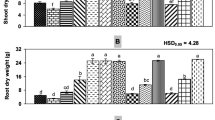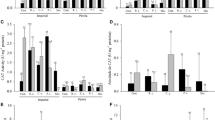Abstract
Glasshouse experiments were conducted twice to assess the effects of soil inoculants (Rhizobium sp., Glomus fasciculatum and Trichoderma harzianum) and wilt fungus Fusarium oxysporum f. sp. ciceri on growth and transpiration of chickpea. Inoculation of F. oxysporum f. sp. ciceri reduced plant growth, transpiration and caused severe wilting. Application of Rhizobium sp., G. fasciculatum and T. harzianum alone or in combination increased chickpea growth of F. oxysporum f. sp. ciceri-inoculated plants and also increased transpiration from 1st week onwards. However, T. harzianum alone had no effect on growth and transpiration of chickpea in plants without F. oxysporum f. sp. ciceri while Rhizobium and G. fasciculatum increased growth and transpiration from 1st week onwards. Use of T. harzianum alone caused a greater increase in growth and transpiration of F. oxysporum f. sp. ciceri inoculated plants than Rhizobium. Better growth and more transpiration of F. oxysporum f. sp. ciceri-inoculated plants was observed when all the three soil inoculants were applied together. This also resulted in lowest wilting index, higher root nodulation and greater root colonization by G. fasciculatum.
Zusammenfassung
In zwei Gewächshausversuchen wurde die Wirkung von Bodeninokulantien (Rhizobium sp., Glomus fasciculatum und Trichoderma harzianum) und des Welkepilzes Fusarium oxysporum f. sp.ciceri auf das Wachstum und die Transpiration von Kichererbsen untersucht. Die Inokulation mit F. oxysporum f. sp. ciceri reduzierte das Pflanzenwachstum sowie die Transpiration und verursachte schwere Welke. Applikation von Rhizobium sp., G. fasciculatum und T. harzianum allein oder in Kombination verbesserte das Wachstum der Pflanzen, die mit F. oxysporum f. sp.ciceri inokuliert worden waren und erhöhten auch die Transpiration von der ersten Woche an. T. harzianum allein beeinflusste jedoch nicht das Wachstum und die Transpiration der nicht mit F. oxysporum f. sp.ciceri inokulierten Kichererbsenpflanzen, während Rhizobium und G. fasciculatum das Wachstum und die Transpiration von der ersten Woche an erhöhten. T. harzianum allein führte zu einem stärkeren Wachstum und zu einer höheren Transpiration in mit F. oxysporum f. sp.ciceri inokulierten Pflanzen als Rhizobium. Gleichzeitige Applikation aller drei Pilzarten verursachte ein verbessertes Wachstum und eine erhöhte Transpiration in den inokulierten Kichererbsenpflanzen. Dadurch wurde auch der Welkeindex vermindert, die Bildung von Wurzelknöllchen gesteigert und die Besiedlung der Wurzeln mit G. fasciculatum vermehrt.
Similar content being viewed by others
Literature
Agrios, G. N.: Plant pathology. Academic Press. United States of America. pp. 635, 1997.
Ayers, W. A., P. B. Adams: Mycoparasitism and its application to biological control of plant diseases. — In: Papavizas, G. C., (ed.): Biological control in crop production, pp. 91–103. Allanheld Osmum & Co., Totowa, NJ, 1981.
Chakraborty, U., B. N. Chakraborty: Interaction of Rhizobium leguminosarum and Fusarium solani f. sp. pisi on pea affecting disease development and phytoalexin production. — Can. J. Bot. 67, 1698–701, 1989.
Chakraborty, U., R. P. Purkayastha: Role of Rhizobitoxine in protecting soybean root from Macrophominaphaseolina infection. — Can. J. Microbiol. 30, 285–289, 1984.
Cook, R. J., K. F. Baker: The nature and practice of biological control of plant pathogens. The American Phytopathological Society, St. Paul, Mn, 1983.
Cruickshank, I. A. M., N. E. Rider: Peronospora tabacina in tobacco: Transpiration, growth and related energy considerations. — Austr. J. Biol. Sci. 14, 45–57, 1961.
Dehne, H. W.: Interaction between vesicular arbuscular mycorrhizal fungi and plant pathogens. — Phytopathology 72, 115–119, 1982.
Dehne, H. W., F. Schönbeck: The influence of endotrophic mycorrhiza on the Fusarium wilt of tomato. — J. Pl. Dis. Prot. 82, 630–632, 1975.
Devlin, R. M., F. H. Witham: Plant Physiology. CBS Publishers and Distributors, New Delhi, India, 2000.
Drapeau, R., J. A. Fortin, C. Cagnon: Antifungal activity of Rhizobium. — Can. J. Bot. 51, 681–2, 1973.
Elad, Y., I. Chet, Y. Henis: Biological control of Rhizoctonia solani in strawberry field by Trichoderma harzianum. — Pl. Soil 60, 245–254, 1981.
Ellis, M. A., D. C. Ferree, D. E. Spring: Photosynthesis, transpiration and carbohydrate content of apple leaves infected by Podosphaera leucotricha. — Phytopathology 71, 392–395, 1981.
Gerwitz, D. L., R. D. Durbin: The influence of rust on the distribution of P32 in the bean plant. — Phytopathology 55, 57–61, 1965.
Giovannetti, M., B. Mosse: An evaluation of techniques for measuring vesicular-arbuscular mycorrhizal infection in roots. — New Phytol. 84, 498–500, 1980.
Graham, J. H., J. A. Menge: Influence of vesicular-arbuscular mycorrhizae and soil phosphorus on take all disease of wheat. — Phytopathology 72, 95–96, 1982.
Graham, J. H., R. T. Leonard, J. A. Menge: Membrane-mediated decreases in root exudation responsible for phosphorus inhibition of vesicular-arbuscular mycorrhiza formation. — Pl. Physiol. 68, 548–552, 1981.
Haque, S. E., A. Gaffar: Use of Rhizobia in the control of root rot diseases of sunflower, okra, soybean and mungbean. — Phytopath. Z. 138, 157–63, 1993.
Lewis, J. A., G. C. Papavizas: Integrated control of Rhizoctonia fruit rot of cucumber. — Phytopathology 70, 85–89, 1980.
Mignucci, J. S., J. S. Boyer: Inhbition of photosynthesis and transpiration in soybean infected by Microsphaera diffusa. — Phytopathology 69, 227–230, 1979.
Morandi, D.: VA mycorrhizae, nematodes, phosphorus, and phytoalexins on soybean. — In: Sylvia, D. M., L. L. Hung, J. H. Graham (eds.): Proceedings of the 7th North American Conference on Mycorrhizae. Mycorrhizae in the Next Decade, Practical Application and Research Priorities. Food and Agricultural Sciences, University of Florida, Gainesville, pp 212
Papavizas, G. C.: Trichoderma and Gliocladium: Biology, ecology and potential for biocontrol. — Ann. Rev. Phytopathol. 23, 23–54, 1985.
Papavizas, G. C., R. D. Lumsden: Biological control of soil borne fungal propagules. — Ann. Rev. Phytopathol. 18, 389–413, 1980.
Papavizas, G. C., J. A. Lewis, T. H. Abd-El Moity: Evaluation of new biotypes of Trichoderma harzianum for tolerance to benomyl and enhanced biocontrol capabilities. — Phytopathology 72, 126–132, 1982.
Phillips, J. M. D. S. Hayman: Improved procedures for clearing roots and obtaining parasitic and vesticular-arbuscular mycorrhizal fungi for rapid assessment of infection. — Trans. Br. Mycol. Soc. 55, 158–161, 1970.
Rangaswami, G.: Diseases of crop plants in India. Prentice-Hall of India Private Limited, New Delhi, 1988.
Riker, A. J., R. S. Riker: Introduction to research on plant diseases. — John’s Swift Co., St. Louis, 1936.
Roslycky, E. B.: Bacteriocin production in the rhizobia bacteria. — Can. J. Microbiol. 13, 431, 1967.
Siddiqui, Z. A., S. I. Husain: Interaction between Meloidogyne incognita race 3, Macrophomina phaseolina and Bradyrhizobium sp. in the root-rot disease complex of chick-pea Cicer arietinum. — Fundam. Appl. Nematol. 15, 491–494, 1992.
Siddiqui, Z. A., I. Mahmood: Effect of Heterodera cajani on growth, chlorophyll content and activity of some enzymes in pigeonpea. — Nematropica 24, 103–111, 1994.
Siddiqui, Z. A., I. Mahmood: Role of plant symbionts in nematode management: a review. — Biores. Technol. 54, 217–226, 1995.
Siddiqui, Z. A., I. Mahmood: Biological control of Heterodera cajani and Fusarium udum on pigeonpea by Glomus mosseae, Trichoderma harzianum and Verticillium chalmydosporium. — Israel J. Pl. Sci. 44, 49–56, 1996.
Singh, R. S.: Plant diseases. Sixth Edition, Oxford and Ibh Publishing Co. Pvt. Ltd., 1996.
Spotts, R. A., D. C. Ferree: Photosynthesis, transpiration and water potential of apple leaves infected by Venturia inaequalis. — Phytopathology 69, 717–719, 1979.
Sylvia, D. M., W. A. Sinclair: Phenolic compounds and resistance to fungal pathogens induced in primary roots of Douglas-fir seedlings by the ectomycorrhizal fungus Laccaris laccata. — Phytopathology 73, 390–397, 1983.
Tu, J. C.: Incidence of root-rot and over-wintering of alfalfa as influenced by Rhizobia. — Phytopath. Z. 97, 233–40, 1980.
Wright, J. M.: The production of antibiotics in soil. Iii. Production of gliotoxin in wheat-straw buried in soil. — Ann. Appl. Biol. 44, 461–466, 1956.
Author information
Authors and Affiliations
Corresponding author
Rights and permissions
About this article
Cite this article
Siddiqui, Z.A., Singh, L.P. Effects of soil inoculants on the growth, transpiration and wilt disease of chickpea. J Plant Dis Prot 111, 151–157 (2004). https://doi.org/10.1007/BF03356141
Received:
Accepted:
Published:
Issue Date:
DOI: https://doi.org/10.1007/BF03356141




